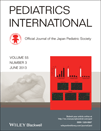Significance of twinkling artifact on ultrasound in the diagnosis of cystine urolithiasis
Abstract
Twinkling artifact (TA) refers to the finding characterized by both a high-echoic mass upon B-mode ultrasound (US) and turbulence-like signals over the entire mass without significant blood flow on color Doppler US. TA is a characteristic sign of urolithiasis, and there has been no previous report on this finding in the digestive tract. The authors recently encountered a 2-year 9-month-old boy with cystinuria presenting with an opacified abdominal mass. Although he was originally diagnosed as having calcified stool mass, the finding of TA upon US led to the correct diagnosis of huge urolith (4.2 cm in diameter) in the urinary bladder. Laparotomic stone removal was successfully conducted and the calculus was confirmed to be composed of cystine. The finding of TA upon US facilitates identification of the structure and location of the intra-abdominal mass.




